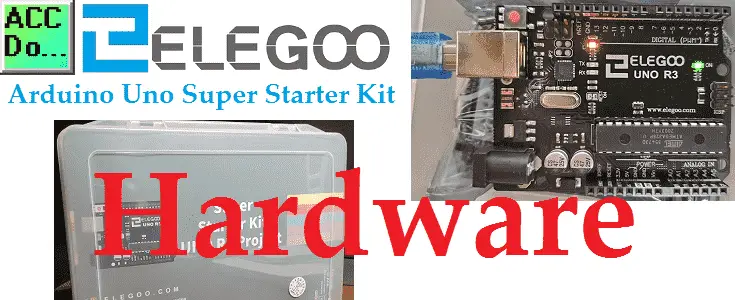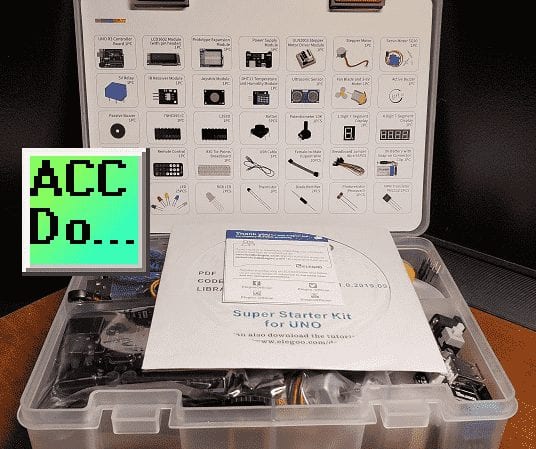Arduino consists of a family of single programmable circuit boards and the IDE (Integrated Development Environment) that uses a streamlined version of C++ to write and upload code to the boards. Many pre-configured circuit boards, called “shields”, are available to expand the functionality of the Arduino controller. These shields can provide Ethernet, WiFi, GPS, LCD displays, and motor controls, among others, by simply “stacking” or connecting the shields to the Arduino controller board. This Lego-style building of electronic devices is becoming more popular.

The Arduino UNO is one of the best board to learn about electronics and coding. This robust board is the most used and documented board of the whole Arduino family.
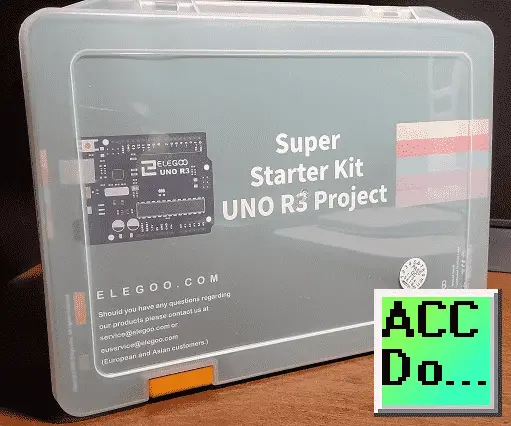
We will be looking at the Elegoo Arduino UNO R3 Super Starter Kit. Opening up this great learning tool and discussing the Uno board itself.
Let’s get started.
A full list of posts in this series can be obtained at the following location:
Arduino Uno Software Super Starter Kit
Watch the video below of the unpacking and powering up of our starter kit. Elegoo Super Starter Kit UNO R3.
What is Arduino?
Arduino consists of a family of single programmable circuit boards and the IDE (Integrated Development Environment) that uses a streamlined version of C++ to write and upload code to the boards.
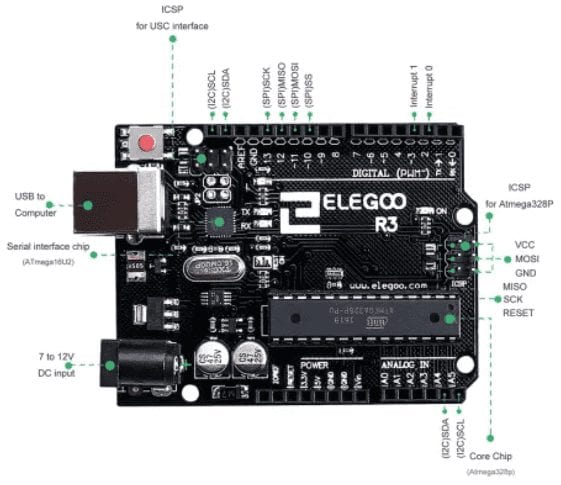
What is “open-source”?
The term “open source” is used to describe a program or software created by one developer that is available to be used and/or modified in any way by other developers and users without licensing fees, royalties due, or restrictions on the use of the source code. Open source has evolved to also include hardware, shared schematics, and PCB production files that are often readily available to anyone. This type of shared development has spawned an enormous “Maker” community. Numerous Maker sites can be found online with a vast collection of simple, helpful, and most of all reusable, DIY projects.
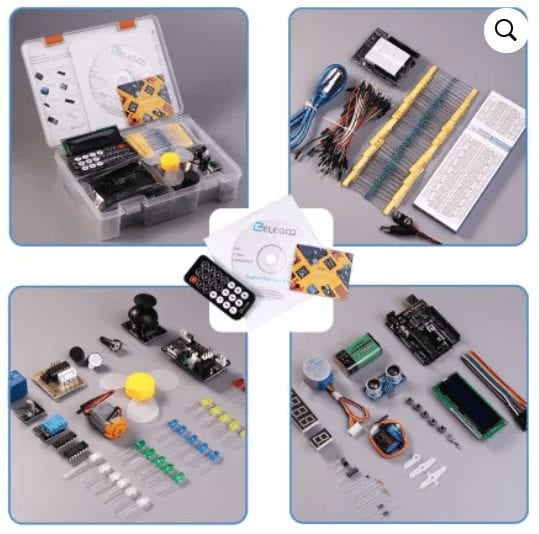
Open-Source Communities
Open-source communities and the websites dedicated to them provide sharing of ideas and finding innovative ways to solve complex problems. Sites like MakerPro and GitHub allow hobbyists and professionals to work together to create interesting solutions for difficult or everyday problems.
Why Arduino Uno?
The Arduino Uno is a microcontroller board based on the ATmega328P chip. It has 14 digital pins. These pins can be programmed as an input or output. Six of these can be used as a PWM (Pulse Width Modulated) output. The board also has 6 analog inputs, a USB connection, a power jack, an ICSP header (In-Circuit Serial Programming), and a reset button. It will operate at a 16 MHz, thanks to a ceramic resonator (CSTCE16M0V53-R0).
Connecting the board to a computer with a USB cable or power it with an AC-to-DC adapter or battery will get you started.
“Uno” means one in Italian. It was released with the Arduino Software (IDE) 1.0. The Uno board and version 1.0 of Arduino Software (IDE) were the reference versions of Arduino, now evolved to newer releases. This is a good board to learn the basics.

Arduino Uno Specifications:
Microcontroller ATmega328P
Operating Voltage 5V
Input Voltage (recommended) 7-12V
Input Voltage (limit) 6-20V
Digital I/O Pins 14 (of which 6 provide PWM output)
PWM Digital I/O Pins 6
Analog Input Pins 6
DC Current per I/O Pin 20 mA
DC Current for 3.3V Pin 50 mA
Flash Memory 32 KB (ATmega328P) of which 0.5 KB used by bootloader
SRAM 2 KB (ATmega328P)
EEPROM 1 KB (ATmega328P)
Clock Speed 16 MHz
LED_BUILTIN 13
Length 68.6 mm
Width 53.4 mm
Weight 25 g
Pinout:
https://content.arduino.cc/assets/Pinout-UNOrev3_latest.pdf
https://store-usa.arduino.cc/products/arduino-uno-rev3/?selectedStore=us
Chip pin output
https://www.arduino.cc/en/Hacking/PinMapping168

Arduino Uno Super Starter Kit Hardware
We have an Elegoo Super Starter Kit for UNO. This kit highlights the following components:
– Uno R3 Controller Board
– Stepper Motor
– Stepper Motor Driver
– Servo Motor
– IR Receiver Module
– 5V Relay
– LCD 1602 Module with a pin header. (No soldering)
– Power Supply Module
– Prototype Expansion Module
– 4-digit and 1 digit 7 segment Displays
– Tilt Ball Switch
– Joystick Module
– Temperature and Humidity Module
– Ultrasonic Sensor
– Fan Blade and 3-6V DC Motor
– Connectors, LED, Breadboards
ETC.
Watch the video below of the unpacking and powering up of our starter kit.

Elegoo Links:
Service
service@elegoo.com (USA and Canada)
EUservice@elegoo.com (Europe)
Arduino Compatible Links:
Product Hardware
Elegoo UNO Project Super Starter Kit
Elegoo Download Page
Amazon.com
Amazon.ca
Software
– Arduino IDE (Integrated Development Environment)
– Productivity Blocks (Development Timesaver)
– Productivity Blocks Documentation (Wiki)
Community
– Arduino Blog
– Arduino Forum
– Arduino UNO Facebook
Next time we will look at installing the software for our Arduino Elegoo super starter kit UNO R3.
Watch on YouTube: Arduino Uno Super Starter Kit Hardware
If you have any questions or need further information please contact me.
Thank you,
Garry
If you’re like most of my readers, you’re committed to learning about technology. Numbering systems used in PLC’s are not difficult to learn and understand. We will walk through the numbering systems used in PLCs. This includes Bits, Decimal, Hexadecimal, ASCII, and Floating Point. To get this free article, subscribe to my free email newsletter.
Use the information to inform other people how numbering systems work. Sign up now. The ‘Robust Data Logging for Free’ eBook is also available as a free download. The link is included when you subscribe to ACC Automation.
The ‘Robust Data Logging for Free’ eBook is also available as a free download. The link is included when you subscribe to ACC Automation.

